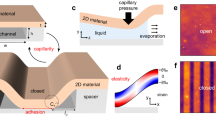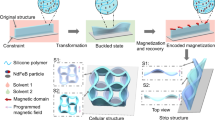Abstract
The pursuit of materials with enhanced functionality has led to the emergence of metamaterials—artificially engineered materials whose properties are determined by their structure rather than composition. Traditionally, the building blocks of metamaterials are arranged in fixed positions within a lattice structure1,2,3,4,5,6,7,8,9,10,11,12,13,14,15,16,17,18,19. However, recent research has revealed the potential of mixing disconnected building blocks in a fluidic medium20,21,22,23,24,25,26,27. Inspired by these recent advances, here we show that by mixing highly deformable spherical capsules into an incompressible fluid, we can realize a ‘metafluid’ with programmable compressibility, optical behaviour and viscosity. First, we experimentally and numerically demonstrate that the buckling of the shells endows the fluid with a highly nonlinear behaviour. Subsequently, we harness this behaviour to develop smart robotic systems, highly tunable logic gates and optical elements with switchable characteristics. Finally, we demonstrate that the collapse of the shells upon buckling leads to a large increase in the suspension viscosity in the laminar regime. As such, the proposed metafluid provides a promising platform for enhancing the functionality of existing fluidic devices by expanding the capabilities of the fluid itself.
This is a preview of subscription content, access via your institution
Access options
Access Nature and 54 other Nature Portfolio journals
Get Nature+, our best-value online-access subscription
$29.99 / 30 days
cancel any time
Subscribe to this journal
Receive 51 print issues and online access
$199.00 per year
only $3.90 per issue
Buy this article
- Purchase on Springer Link
- Instant access to full article PDF
Prices may be subject to local taxes which are calculated during checkout




Similar content being viewed by others
Data availability
The data that support the findings of this study are openly available in GitHub at https://github.com/BertVanRaemdonck/Buckling-Capsule-Metafluids.
References
Engheta, N. & Ziolkowski, R. W. Metamaterials: Physics and Engineering Explorations (Wiley, 2006).
Craster, R. V. & Guenneau, S. Acoustic Metamaterials: Negative Refraction, Imaging, Lensing and Cloaking Vol. 166 (Springer Science & Business Media, 2012).
Deymier, P. A. Acoustic Metamaterials and Phononic Crystals Vol. 173 (Springer Science & Business Media, 2013).
Maldovan, M. Narrow low-frequency spectrum and heat management by thermocrystals. Phys. Rev. Lett. 110, 025902 (2013).
Bertoldi, K., Vitelli, V., Christensen, J. & Van Hecke, M. L. Flexible mechanical metamaterials. Nat. Rev. Mater. 2, 17066 (2017).
Kadic, M., Bückmann, T., Schittny, R. & Wegener, M. Metamaterials beyond electromagnetism. Rep. Prog. Phys. 76, 126501 (2013). ISSN 0034-4885.
Christensen, J., Kadic, M., Kraft, O. & Wegener, M. Vibrant times for mechanical metamaterials (book review). MRS Commun. 5, 453–462 (2015).
Lee, G. et al. Piezoelectric energy harvesting using mechanical metamaterials and phononic crystals. Commun. Phys. 5, 94 (2022).
Xu, X. et al. Multifunctional metamaterials for energy harvesting and vibration control. Adv. Funct. Mater. 32, 2107896 (2022).
Hu, G., Tang, L., Liang, J., Lan, C. & Das, R. Acoustic-elastic metamaterials and phononic crystals for energy harvesting: a review. Smart Mater. Struct. 30, 085025 (2021).
Chen, Z., Guo, B., Yang, Y. & Cheng, C. Metamaterials-based enhanced energy harvesting: a review. Physica B 438, 1–8 (2014).
Fowler, C., Silva, S., Thapa, G. & Zhou, J. High efficiency ambient RF energy harvesting by a metamaterial perfect absorber. Opt. Mater. Express 12, 1242–1250 (2022).
Ramahi, O. M., Almoneef, T. S., AlShareef, M. & Boybay, M. S. Metamaterial particles for electromagnetic energy harvesting. Appl. Phys. Lett. 101, 173903 (2012).
Lin, Keng-Te., Lin, H., Yang, T. & Jia, B. Structured graphene metamaterial selective absorbers for high efficiency and omnidirectional solar thermal energy conversion. Nat. Commun. 11, 1389 (2020).
Cortés, E. et al. Optical metasurfaces for energy conversion. Chem. Rev. 122, 15082–15176 (2022).
Patel, S. K., Surve, J., Katkar, V. & Parmar, J. Optimization of metamaterial-based solar energy absorber for enhancing solar thermal energy conversion using artificial intelligence. Adva. Theory Simul. 5, 2200139 (2022).
Chen, T., Li, S. & Sun, H. Metamaterials application in sensing. Sensors 12, 2742–2765 (2012).
Molerón, M. & Daraio, C. Acoustic metamaterial for subwavelength edge detection. Nat. Commun. 6, 8037 (2015).
Fan, W., Yan, B., Wang, Z. & Wu, L. Three-dimensional all-dielectric metamaterial solid immersion lens for subwavelength imaging at visible frequencies. Sci. Adv. 2, e1600901 (2016).
Urzhumov, Y. A. et al. Plasmonic nanoclusters: a path towards negative-index metafluids. Opt. Express 15, 14129–14145 (2007).
Sheikholeslami, S. N., Alaeian, H., Koh, Ai. Leen. & Dionne, J. A. A metafluid exhibiting strong optical magnetism. Nano Lett. 13, 4137–4141 (2013).
Yang, J. et al. Broadband absorbing exciton-plasmon metafluids with narrow transparency windows. Nano Lett. 16, 1472–1477 (2016).
Hinamoto, T., Hotta, S., Sugimoto, H. & Fujii, M. Colloidal solutions of silicon nanospheres toward all-dielectric optical metafluids. Nano Lett. 20, 7737–7743 (2020).
Kim, K., Yoo, SeokJae, Huh, Ji-Hyeok, Park, Q.-Han & Lee, S. Limitations and opportunities for optical metafluids to achieve an unnatural refractive index. ACS Photon. 4, 2298–2311 (2017).
Cho, Y. et al. Using highly uniform and smooth selenium colloids as low-loss magnetodielectric building blocks of optical metafluids. Opt. Express 25, 13822–13833 (2017).
Brunet, T. et al. Soft 3D acoustic metamaterial with negative index. Nat. Mater. 14, 384–388 (2015).
Peretz, O., Ben Abu, E., Zigelman, A., Givli, S. & Gat, A. D. A metafluid with multistable density and internal energy states. Nat. Commun. 13, 1810 (2022).
Djellouli, A., Marmottant, P., Djeridi, H., Quilliet, C. & Coupier, G. Buckling instability causes inertial thrust for spherical swimmers at all scales. Phys. Rev. Lett. 119, 224501 (2017).
Jambon-Puillet, E., Jones, T. J. & Brun, P.-T. Deformation and bursting of elastic capsules impacting a rigid wall. Nat. Phys. 16, 585–589 (2020).
Utada, A. S. Monodisperse double emulsions generated from a microcapillary device. Science 308, 537–541 (2005).
Chen, Q. Robust fabrication of ultra-soft tunable PDMS microcapsules as a biomimetic model for red blood cells. Soft Matter 19, 5249–5261 (2023).
Puglisi, G. & Truskinovsky, L. Mechanics of a discrete chain with bi-stable elements. J. Mech. Phys. Solids 48, 1–27 (2000).
Benichou, I. & Givli, S. Structures undergoing discrete phase transformation. J. Mech. Phys. Solids 61, 94–113 (2013).
Nagelberg, S. et al. Reconfigurable and responsive droplet-based compound micro-lenses. Nat. Commun. 8, 14673 (2017).
Guazzelli, É., Morris, J. F. & Pic, S. A Physical Introduction to Suspension Dynamics Cambridge Texts in Applied Mathematics (Cambridge Univ. Press, 2011).
Shewan, H. M. & Stokes, J. R. Viscosity of soft spherical micro-hydrogel suspensions. J. Colloid Interface Sci. 442, 75–81 (2015).
Shewan, H. M. & Stokes, J. R. Analytically predicting the viscosity of hard sphere suspensions from the particle size distribution. J. Nonnewton. Fluid Mech. 222, 72–81 (2015).
Dressaire, E. & Sauret, A. Clogging of microfluidic systems. Soft Matter 13, 37–48 (2017).
Chien, S., Usami, S. & Bertles, J. F. Abnormal rheology of oxygenated blood in sickle cell anemia. J. Clin. Invest. 49, 623–634 (1970).
Acknowledgements
This research was supported by NSF through the Harvard University Materials Research Science and Engineering Center grant number DMR-2011754, the Fund for Scientific Research-Flanders (FWO) and the European Research Council (ERC starting grant ILUMIS). We thank G. Mckinley and B. Keshavarz and S. Sun for their help with the rheology tests; G. Coupier for the idea of a pressure-driven flow; A. Meeussen, N. Rubin, S. Wei, D. Lim and A. Dorrah for their help with optical experiments; and C. McCann and A. Watkins for comments on the paper.
Author information
Authors and Affiliations
Contributions
A.D., B.G., B.V.R. and K.B. proposed and developed the research idea. A.D., Y.Y. and A.C. designed and fabricated the centimetre-scale capsules. Y.W. fabricated and characterized the micrometre-scale capsules. A.D. designed and conducted the experiments and optical simulations. B.V.R. conducted the numerical calculations. A.D., B.V.R. and K.B. wrote the paper. K.B., B.G., S.R. and D.W. supervised the research.
Corresponding authors
Ethics declarations
Competing interests
The authors declare no competing interests.
Peer review
Peer review information
Nature thanks Thomas Brunet, Corentin Coulais and the other, anonymous, reviewer(s) for their contribution to the peer review of this work. Peer reviewer reports are available.
Additional information
Publisher’s note Springer Nature remains neutral with regard to jurisdictional claims in published maps and institutional affiliations.
Supplementary information
Supplementary Information
This file contains Supplementary text, Figs. 1–28, Tables 1 and 2, and References.
Supplementary Video 1
Pressure–volume curve of a single capsule.
Supplementary Video 2
Pressure–volume curve of the metafluid.
Supplementary Video 3
Smart gripper.
Supplementary Video 4
Interactions with flexible structures.
Supplementary Video 5
Tunable optical properties.
Supplementary Video 6
Pressure-driven flow.
Rights and permissions
Springer Nature or its licensor (e.g. a society or other partner) holds exclusive rights to this article under a publishing agreement with the author(s) or other rightsholder(s); author self-archiving of the accepted manuscript version of this article is solely governed by the terms of such publishing agreement and applicable law.
About this article
Cite this article
Djellouli, A., Van Raemdonck, B., Wang, Y. et al. Shell buckling for programmable metafluids. Nature 628, 545–550 (2024). https://doi.org/10.1038/s41586-024-07163-z
Received:
Accepted:
Published:
Issue Date:
DOI: https://doi.org/10.1038/s41586-024-07163-z
This article is cited by
-
A quirky fluid that has robotic capabilities
Nature (2024)
Comments
By submitting a comment you agree to abide by our Terms and Community Guidelines. If you find something abusive or that does not comply with our terms or guidelines please flag it as inappropriate.



